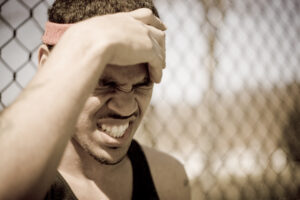Burnout is all too common for young athletes, but it can be prevented when you spot the signs and signals for potential burnout. In most cases it’s not a matter of working harder or being better. In fact focusing on working harder or focusing on being better can actually drive burnout rather than prevent it.
Let’s start with some common signs that your child athlete is heading for burnout.
Number 1: The athlete has a poor mental attitude on and off the field of competition. Often, this can be due to the athlete not performing to his or her expectations which leads to a negative focus. This usually has the athlete focusing on everything that’s not going right rather than on what needs to be changed or focused on to right this ship.

Number 2: The athlete has poor sleep or troubled giving the right amount of sleep. This can be due to overtraining or from having excess mental or emotional stress. Both of these causes will disrupt sleep quality and quantity of the athlete’s sleep. And poor sleep can lead directly into burnout.
Number 3: The athlete often gets injured. This could be caused by many issues including poor sleep quality and quantity, poor posture alignment, muscular imbalances, poor movement mechanics, or over training just to name a few. When an athlete gets injured or dinged up often, this can be extremely frustrating for the athlete and lead to burnout.
Number 4: The athlete lacks energy or enthusiasm. Although there can be many causes for this issue, overtraining can be the sneaky and surprising cause that can lead to low energy and lack of enthusiasm. 
Number 5: The athlete lacks a normal appetite. Lack of a normal appetite can be due to an eating disorder or even possibly some sort of illness. In this case, if the athlete is lacking a normal appetite you will want to eliminate both an eating disorder and an illness first. But the most common cause of poor appetite or lacking the normal appetite goes back to overtraining.
The next area that can help you and your child athlete get to the cause of burnout is establishing open communication with your child athlete.
To do this, set some time for you and your child to talk. There are some ground rules for both you and your child to make this a successful endeavor.

First allow your child to share 80% of the time. This can be a challenge if your child is shut down. Even if this is the case you want to create the space for your child to feel free to share his or her internal feelings.
Second, don’t judge your child’s words. Obviously, you’ll have rules about swearing and such, and those should be followed. But you don’t want your child to feel under attack or judged for opening up.
Third, both you and your child need to keep this a blame free space. At least between you and your child. You also want to limit how you and your child blame other people or events that are not part of the conversation. The main reason for this is when you blame others, events, or anything else you remove any power for you or your child to change the circumstances that you are currently dealing with. Although this can be tough, you and your child should ultimately be using this open communication forum to create strategies to get to a better stage.

Finally, the fourth rule is if any rules are broken or if things get heated out of control allow time for all involved to cool down prior to coming back to talk. Then if a rule was broken, the person that broke the rule needs to acknowledge this mistake and then move it back into communicating. Remember children are working through many things and discovering their ability to communicate is a major one. They will not be as good initially as they can be. Allow these mistakes without pointing out each mistake.
Now, focus on creating strategies to help your child athlete prevent burnout from happening.
There are two main areas that lead to burnout. There’s the physical and then there’s the mental/emotional area.
Whether it’s physical or mental/emotional, the first step is understanding what the overall dream or goal is for the athlete. For example is it to become a professional athlete? Or achieve a scholarship? Or even becoming a starter on the team?
Next, if you have a challenging relationship with your child, it might be a good idea, for the sake of achieving the overall dream, to bring in someone else that your child would be more open to discussing and accepting feedback from. This includes a coach or trainer, a counselor, or a trusted friend for a few examples.

If the issue is physical, you need to make sure that there’s a balance between the work and rest. Work includes strength training, practices, competition, school, chores, etcetera. If it’s a matter of lack of results compared to expectations and there is a good balance between work and rest, then you may need to look for additional expertise such as the right coach or the right trainer.
If the issue is mental or emotional there needs to be a focus on what the overall dream is and what is the biggest current controllable obstacle in the way of accomplishing this dream.
And don’t forget:
The participation in athletics is supposed to be fun. As an athlete rises up in levels of competition, it can be more difficult to find the joy and fun in athletics. This should be a key emphasis, regardless of whether the athlete is suffering from burnout or not!
The next area to focus on with the mental and emotional issues leading to burnout, is to help your child create a list of all his or her responsibilities in life.
This includes all the athletics related, school related, family related, and friend related. Also include the areas that your child enjoys as well.

From here create a hierarchy of which is the most important to least important. Decide which of these responsibilities or activities can be dropped or deferred when the stress or pressure gets to be too much. Make sure your child understands what areas need to be kept up and which areas he or she can defer or stop all together when the stress or pressure gets to be too much. Constantly revisit this throughout the time during athletics to see if adjustments need to be made.
